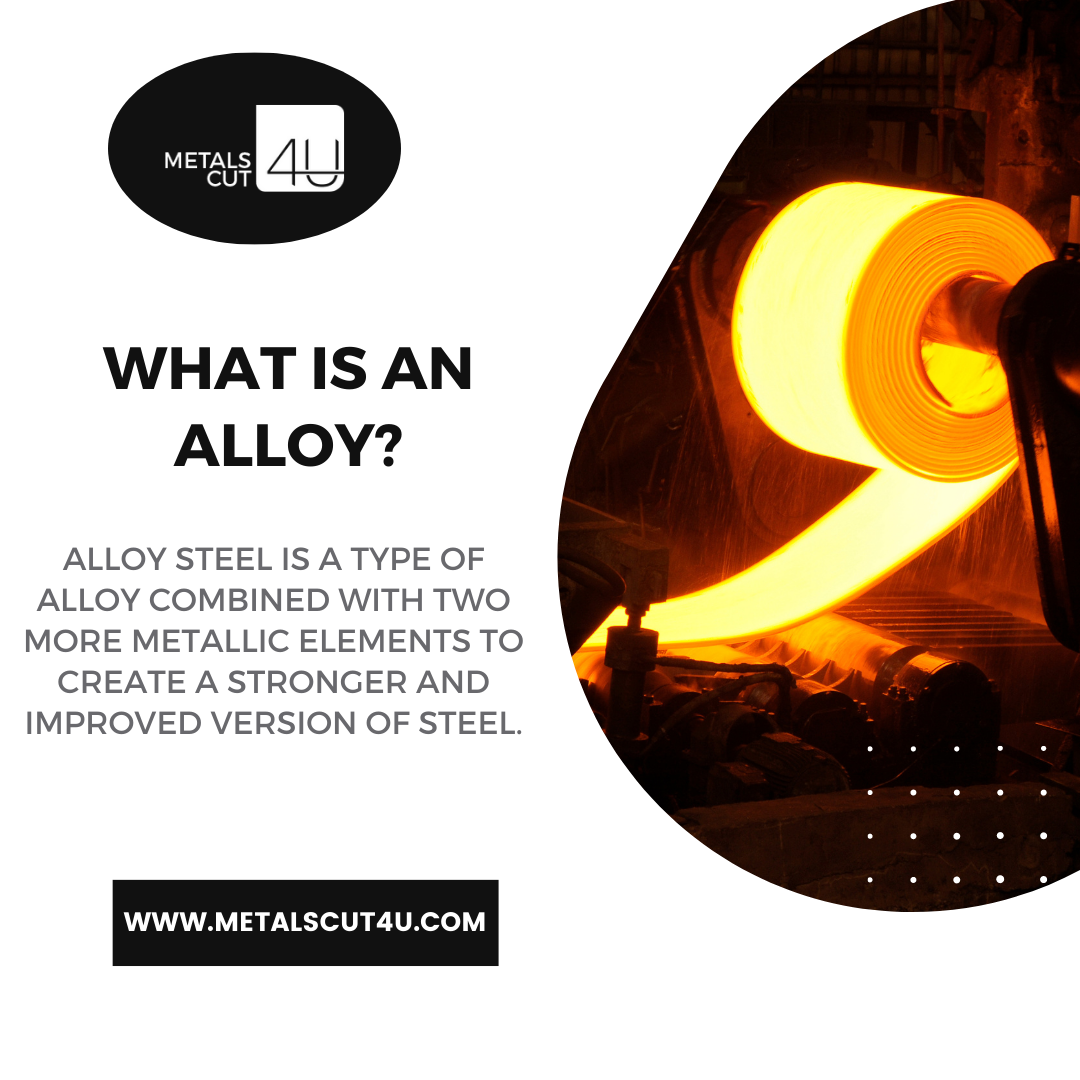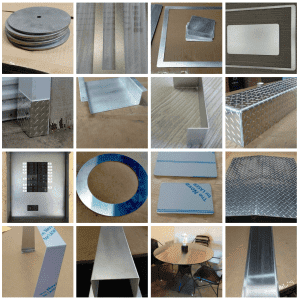What is An Alloy - Properties, Composition, And Advantages

Steel is the most used and preferred metal across the world. Several industries and manufacturing sectors rely heavily on steel to construct different types of applications and equipment. At times, steel alone can not fulfill certain requirements and is mixed with other robust and complementary metals.
When combined with different metallic elements, steel alloy has a greater ability to withstand pressure and shock, and has strong resistance to rust and corrosion. It is an excellent technique to add more properties to the metal cost-effectively. With good composition and increased properties, alloy steel becomes equivalent to other naturally strong and tough metals.
Depending on your project needs and requirements, you can blend the components to fabricate desired steel alloys of different types and properties. It is vital to understand the properties of elements different metals possess before combining them with steel. Some metals consume less time and effort to fabricate desired alloy metals, whereas others can deteriorate the host metal properties due to a lack of compatibility and complex procedure.
Let us begin this blog by understanding what an alloy is and the ways you can get the desired outcomes.
What is Alloy Steel?
Alloy steel is a type of alloy combined with two more metallic elements to create a stronger and improved version of steel. Molybdenum, manganese, nickel, chromium, vanadium, silicon, and boron are some of the most common and widely used metallic elements to create steel alloys.
Depending on the need and requirements of your project, the composition of steel alloy may vary. At Metals Cut4U, we offer custom-cut metal services to give the desired shape and pattern to metal sheets. To learn more about our services, call us at 440-822-6381.
What Are Steel Alloy Composition?
Iron and carbon together make steel. To enhance the properties of steel, the alloy is further mixed with different metal elements. Here are some popular metallic elements mixed to create different steel alloy compositions.
1. Magnesium
Magnesium is the most preferred metal to increase the hardness and stability of a metal structure. Additionally, magnesium is also used to reduce the corrosion rate and increase the toughness of the metal.
2. Nickel
Similar to magnesium, nickel is used to increase the strength and toughness of the metal structure. This element is an austenite stabilizer that helps in improving corrosion resistance and oxidizing properties.
3. Titanium
Titanium is considered one of the strongest and toughest metals on the earth. Mixing titanium with steel can help you create a standard quality and durable alloy for your construction and other project purposes.
4. Copper
Generally, a small amount of copper is mixed with steel to improve the rust and corrosion resistance properties. An excessive amount of copper can make it difficult to wield and have adverse effects on the final product.
5. Chromium
Chromium is the most preferred element to enhance the toughness and hardness of steel at high temperatures. Compared to other metals, chromium can withstand high-temperature and create desired results without losing its essential properties during the process.
6. Aluminum
Aluminum is a non-ferrous metal that is naturally resistant to rust and corrosion. Mixing aluminum can help you achieve excellent lightweight steel alloy composition.
7. Silicon
Silicon can be used to purify the metal and improve oxidation resistance in the metal.
What Are The Advantages of Alloy Steel?
Now, let us look at some major advantages of alloy steel that can significantly benefit your business in unique ways.
1. Improved toughness
To increase the toughness and tensile strength of steel, mixing different metallic elements can help avoid expensive costs and secure the original properties of steel. Sometimes, steel alone cannot provide the necessary strength and resistant properties required for certain applications. Opting for alloy steel will help you achieve desired properties for your metal structure.
2. Versatility
Compared to pure steel, alloy steel is more versatile and offers improved properties suitable for various applications. Alloying steel with different elements can enable more enhancements of certain properties required in various applications.
3. Increase rust resistance
Rusting is one of the most common and damaging problems. Alloying steel with rust and corrosion-resistant metal elements can reduce metal susceptibility to chemical reactions and weather influences.
4. Aids in metal casting
Generally, pure steel and other metals contrast and melt slightly when solidified. But when alloyed, steel tends to expand during solidification and thus resulting in good casting.
What Are Alloys Used For?
Alloy steels are the most preferred and versatile metal used to serve various construction and manufacturing purposes. Alloys are used for making metal structures that can easily withstand rusting, corrosion, pressure and shock and have high resistance to different climatic conditions. In other words, applications that are required to last longer and withstand extensive pressure are made from alloy steel.
Hence, construction, automobiles, wildcraft, military, and medical industries rely heavily on alloy steel to produce various business equipment and tools.
Different Types of Shapes And Material Of Alloy Steel
1. Low-alloy steel
Alloy steel that contains non-iron elements less than 1-5 % is called low-alloy steel. Low-alloy steel is readily available and cheaper compared to high-alloy steel. This type of alloy steel is more commonly used in military vehicles, construction equipment, ships, pipelines, pressure vessels, and other structural components.
2. High-strength low alloy steel
High-strength low alloy steel or HSLA steel is an alloy steel that contains carbon elements between 0.02 to 0.2%. HSLA steel offers more tensile strength and toughness than low-alloy steel and is widely used by construction and manufacturing industries. HSLA steels are used in cars, trucks, bridges, cranes, roller coasters, and other related structural applications.
3. High-alloy steel
High-alloy steel contains more alloying elements than low-alloy steel, that is 8% more elements by weight than carbon and iron. High-alloy steel is more expensive and complex to produce than low-alloy steel. This alloy steel is widely used in automobiles, buildings, infrastructure, machines, ships, trains, and other related applications.
4. Stainless steel
Stainless steel is a rust and corrosion-resistant alloy used in an extensive range of applications. Stainless steel alloy contains iron, chromium, nickel, and other elements.
Properties of Alloy Steel
Properties of alloy steel may vary depending on the alloy composition. For example,
-
0.95-1.3 wt. % of aluminum is used as an alloying element to nitriding steels.
-
0.001-0.003% of boron is used to improve hardenability.
-
0.5-2.0% of chromium is used to improve hardenability.
-
4-18% of chromium is used for corrosion resistance.
-
0.25-0.40 % of manganese along with sulfur is used to prevent brittleness.
Is Alloy Steel Strong?
Alloy steel contains more rust, corrosion, and high-tensile strength properties than pure steel. Alloy steel is more in demand due to its high strength, toughness, hardness, machinability, and versatility compared to other pure metals.
Comparison: Alloy Steel VS Metal
Unlike alloy steel, metal is a naturally occurring element found in the earth’s crust. Alloy steel contains different metallic elements that make it suitable for various applications and construction purposes. It can be challenging to use pure metal alone to get desired construction results. Hence, alloy steel is a more compatible material than the pure metal.
Metal is best suited for making jewelry, decorative projects/items, and other surgical implants. From small tools such as screws to heavy construction equipment, alloy steel is used for various purposes.
Alloy Steel VS Metal: Which One to Choose?
Which one to choose depends on the need and purpose of your project. You can not choose low tensile strength and non-rust and corrosion-resistant materials for various construction purposes.
FAQ
1. What elements make steel?
Iron, carbon, magnesium, chromium, phosphorus, sulfur, nickel, copper, and other elements combined together make steel. To make steel alloy you can increase the quantity of some elements or add new elements.
2. Is steel an alloy of iron?
Yes, iron and carbon are the key elements of steel. When iron in high quantity and carbon in low quantity mix together, they form an alloy called steel.
3. What is low alloy steel?
Alloy steel that contains about 1-5% alloy elements is known as low alloy steel. Low alloy steel consumes less time processing time and is widely used alloy steel across the world.
4. Is stainless steel a metal alloy?
Yes, stainless steel is made by mixing iron, carbon, chromium, and in some cases, even nickel and other metals to make corrosion-resistant stainless steel alloy.
5. Is alloy steel stronger than steel?
Compared to carbon steel or normal steel, alloy steel contains higher tensile strength and excellent rust and corrosion resistance properties.
We hope this blog helped you find solutions to all your “What is an alloy?” concerns. To learn more about the melting point of metal or metals that don’t rust or the services we offer, call us at 440-822-638.
